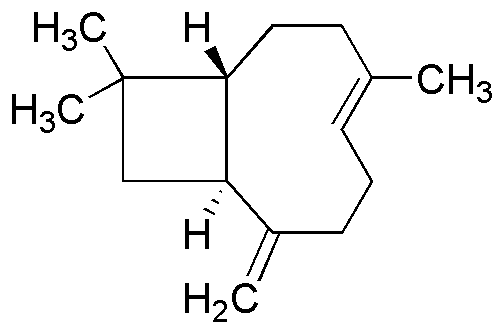b-Caryophyllene is widely utilized in research focused on:
- Flavor and Fragrance Industry: This compound is commonly used as a natural flavoring agent in food products and as a fragrance in perfumes due to its pleasant spicy aroma.
- Pharmaceuticals: It has shown potential anti-inflammatory and analgesic properties, making it a candidate for developing new medications for pain relief and inflammation management.
- Cosmetics: b-Caryophyllene is incorporated into skincare products for its anti-inflammatory benefits, helping to soothe irritated skin and improve overall skin health.
- Aromatherapy: Its unique scent is popular in essential oils, providing calming effects and promoting relaxation when used in diffusers or massage oils.
- Biopesticides: This compound acts as a natural insect repellent, offering an eco-friendly alternative to synthetic pesticides in agriculture, thereby supporting sustainable farming practices.
General Information
Properties
Safety and Regulations
Applications
b-Caryophyllene is widely utilized in research focused on:
- Flavor and Fragrance Industry: This compound is commonly used as a natural flavoring agent in food products and as a fragrance in perfumes due to its pleasant spicy aroma.
- Pharmaceuticals: It has shown potential anti-inflammatory and analgesic properties, making it a candidate for developing new medications for pain relief and inflammation management.
- Cosmetics: b-Caryophyllene is incorporated into skincare products for its anti-inflammatory benefits, helping to soothe irritated skin and improve overall skin health.
- Aromatherapy: Its unique scent is popular in essential oils, providing calming effects and promoting relaxation when used in diffusers or massage oils.
- Biopesticides: This compound acts as a natural insect repellent, offering an eco-friendly alternative to synthetic pesticides in agriculture, thereby supporting sustainable farming practices.
Documents
Safety Data Sheets (SDS)
The SDS provides comprehensive safety information on handling, storage, and disposal of the product.
Product Specification (PS)
The PS provides a comprehensive breakdown of the product’s properties, including chemical composition, physical state, purity, and storage requirements. It also details acceptable quality ranges and the product's intended applications.
Certificates of Analysis (COA)
Search for Certificates of Analysis (COA) by entering the products Lot Number. Lot and Batch Numbers can be found on a product’s label following the words ‘Lot’ or ‘Batch’.
*Catalog Number
*Lot Number
Certificates Of Origin (COO)
This COO confirms the country where the product was manufactured, and also details the materials and components used in it and whether it is derived from natural, synthetic, or other specific sources. This certificate may be required for customs, trade, and regulatory compliance.
*Catalog Number
*Lot Number
Safety Data Sheets (SDS)
The SDS provides comprehensive safety information on handling, storage, and disposal of the product.
DownloadProduct Specification (PS)
The PS provides a comprehensive breakdown of the product’s properties, including chemical composition, physical state, purity, and storage requirements. It also details acceptable quality ranges and the product's intended applications.
DownloadCertificates of Analysis (COA)
Search for Certificates of Analysis (COA) by entering the products Lot Number. Lot and Batch Numbers can be found on a product’s label following the words ‘Lot’ or ‘Batch’.
*Catalog Number
*Lot Number
Certificates Of Origin (COO)
This COO confirms the country where the product was manufactured, and also details the materials and components used in it and whether it is derived from natural, synthetic, or other specific sources. This certificate may be required for customs, trade, and regulatory compliance.


